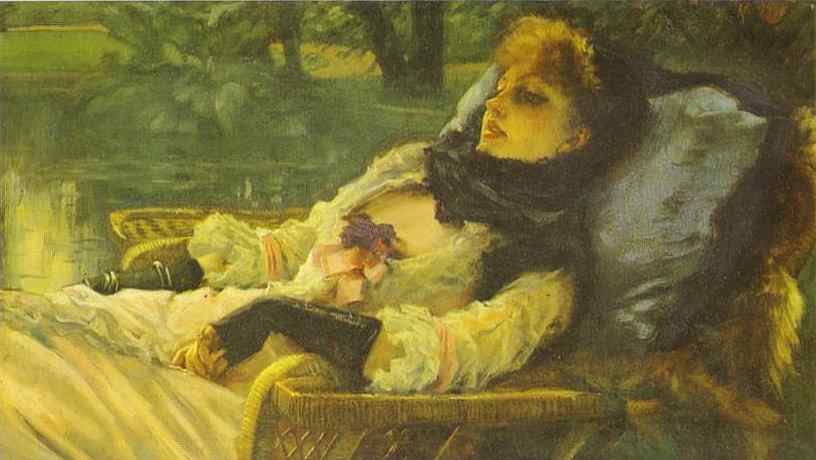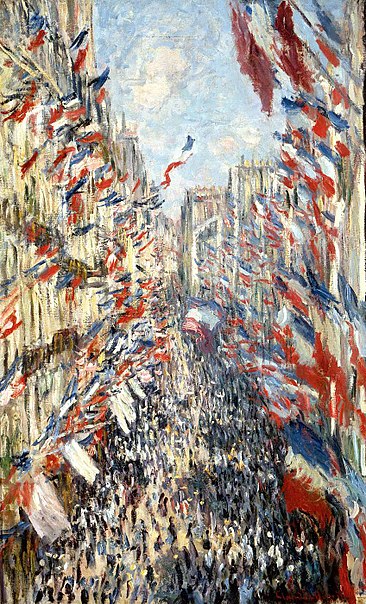
On May 21st I went to The Birth of Impressionism: Masterpieces from the Musée d'Orsay at the DeYoung Museum in San Francisco with my friend, who is a member. It was a preview for members as the exhibit runs from May 22 to September 6th. To prepare for my trip I read this most excellent book called, The Private Lives of the Impressionists
 The rest of the show was absolutely beautiful and makes one want to spend hours and perhaps days at the actual Musée d'Orsay rather than quench one's desire. One of my favorites was from Alfred Stevens (1817-1875) painting, The Bath. This painting was considered scandalous at the time as all the Impressionist's work was. What I love about this paining is how she relaxed in a luxurous bath holding roses with a beautiful robe and book open. In person, this painting's colors were sumptuous. The woman's expression is one of thoughtful contentment who really doesn't care to acknowledge the audience. This woman knows how to relax and surround herself with beautiful things. She is not even paying attention to the watch in the soapdish. This redhead is a reader and dreamer like myself. I indentified with this woman.
The rest of the show was absolutely beautiful and makes one want to spend hours and perhaps days at the actual Musée d'Orsay rather than quench one's desire. One of my favorites was from Alfred Stevens (1817-1875) painting, The Bath. This painting was considered scandalous at the time as all the Impressionist's work was. What I love about this paining is how she relaxed in a luxurous bath holding roses with a beautiful robe and book open. In person, this painting's colors were sumptuous. The woman's expression is one of thoughtful contentment who really doesn't care to acknowledge the audience. This woman knows how to relax and surround herself with beautiful things. She is not even paying attention to the watch in the soapdish. This redhead is a reader and dreamer like myself. I indentified with this woman. 
Speaking of dreamers, another painting I loved was James Tissot's The Dreamer (Summer Evening). Now, Tissot (1836–1902) is not normally considered a heavy hitter in the legion of Impressionists, but there is a reason this painting was included in this exhibit. According to The Private Lives of Impressionists, Tissot as Alfred Stevens were the most commercially successful as they moved to England. I just love the palatte, the glow, and how this painting communicates the act of dreaming. This woman sits in a comfortable oversized chair with an huge fluffy pillow. She is sitting next to a lake or pond in the evening and perhaps is gazing into a campfire. Something in the air whether it is music, smells, or the beauty around her transports her into a dreaming state. It is interesting to note that this painting is listed as being painted in 1871, the roughest of years.
Claude Monet's painting, Rue Montorgueil, Paris,
 Festival of June 30, 1878, is a joyous creation that really captures the emotions of celebration. There is a riot of color, excitement, movement, and the need to celebrate France seven years after the disasterous Franco-Prussian War and the 1871 Commune. There is unity of a people conveyed in this painting. People are in the streets together in a positive way. It is suggestive of better times ahead despite the dark memories. I could actually hear the roar of the crowds and the sounds of the furling flags snapping from the wind. You almost can imagine that the clouds are being pushed across the sky by that same wind.
Festival of June 30, 1878, is a joyous creation that really captures the emotions of celebration. There is a riot of color, excitement, movement, and the need to celebrate France seven years after the disasterous Franco-Prussian War and the 1871 Commune. There is unity of a people conveyed in this painting. People are in the streets together in a positive way. It is suggestive of better times ahead despite the dark memories. I could actually hear the roar of the crowds and the sounds of the furling flags snapping from the wind. You almost can imagine that the clouds are being pushed across the sky by that same wind.I purchased this print as a postcard and bought cups of Degas' The Dancing Lesson also at the exhibit. The dancer in the foreground standing by the piano has this red bow in her hair that really pops. I also dug The Floor Scrapers, by Gustave Caillebotte for his wonderful sense of texture with the curls of wood and the contours of the workmen's muscles. I don't recall disliking any of the paintings and I have to say my appreciation of Impressionism deepend and ripened through seeing the paintings in person and reading about the lives of these painters. The exhibit shows you what work the establishment expected: representational work with bibical or mythological subjects. The Impressionists fearlessly broke the rules and were called insane madmen.
The DeYoung will have the second part of their exhibit starting on September 25th called, Van Gogh, Gauguin, Cézanne and Beyond: Post-Impressionist Masterpieces from the Musée d’Orsay. It is certainly on my calendar.
Starting on June 5th, the Legion of Honor will be having an exhibit Impressionist Paris: City of Light, which:
explores various aspects of Parisian society and the French art world from roughly 1850 to the turn of the 20th century. Picturesque views of the narrow streets and stone bridges of old Paris by Charles Marville, Charles Meryon, and Johan Barthold Jongkind give way to colorful images of modern Parisian life, with Edgar Degas, Pierre Bonnard, Edouard Vuillard, and Georges Seurat offering public and private views of the bustling metropolis. Prints and periodicals featuring the work of Honoré Daumier, Edouard Manet, Paul Signac, and James Tissot convey key historical events and underscore the emergent role of illustrated art journalism. A gallery of black-and-white works on paper by Claude Monet, Camille Pissarro, Mary Cassatt, and Paul Gauguin reveal another side of the exhibition. The spectacle of modern life is conveyed through galleries devoted to popular entertainment in late 19th-century Paris, including colorful images of the theater, café-concerts, circus, as well as the Expositions Universelles. The exhibition concludes in a blaze of color with a selection of posters of the turn of the 20th century by Henri de Toulouse-Lautrec, Jules Chéret, Théophile Steinlen, and Alphonse Mucha.
No comments:
Post a Comment